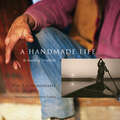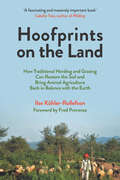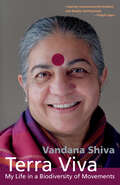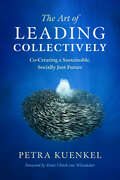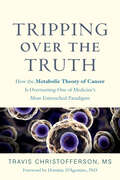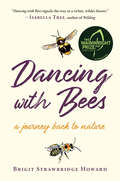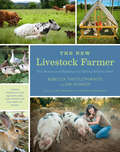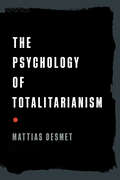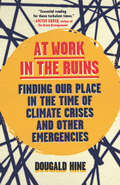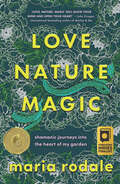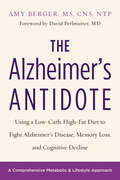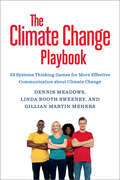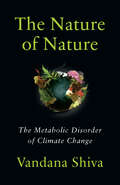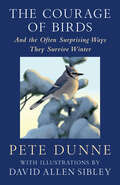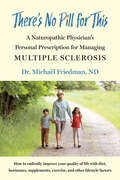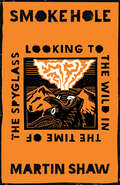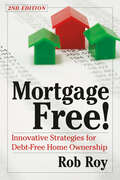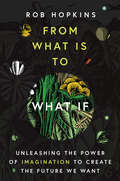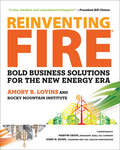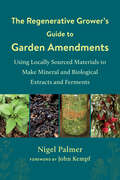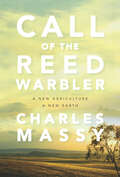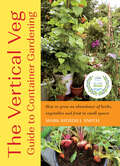- Table View
- List View
A Handmade Life: In Search of Simplicity
by William Coperthwaite John Saltmarsh"A richly textured exploration of Bill Coperthwaite's work and thought, encouraging us to take the lessons of his life to heart. Each of us has the potential to craft our own lives with our own hands—actively, joyfully, and nonviolently, drawing upon the wisdom of our ancestors, striving for justice in the present, and fulfilling our obligations to those who will inherit our legacy."—John SaltmarshWilliam Coperthwaite is a teacher, builder, designer, and writer who for many years hasexplored the possibilities of true simplicity on a homestead on the north coast of Maine. In the spirit of Henry David Thoreau, Emily Dickinson, and Helen and Scott Nearing, Coperthwaite has fashioned a livelihood of integrity and completeness-buying almost nothing, providing for his own needs, and serving as a guide and companion to hundreds of apprentices drawn to his unique way of being.A Handmade Life carries Coperthwaite&’s ongoing experiments with hand tools, hand-grown and gathered food, and handmade shelter, clothing, and furnishings out into the world to challenge and inspire. His writing is both philosophical and practical, exploring themes of beauty, work, education, and design while giving instruction on the hand-crafting of the necessities of life. Richly illustrated with luminous color photographs by Peter Forbes, the book is a moving and inspirational testament to a new practice of old ways of life.
Hoofprints on the Land: How Traditional Herding and Grazing Can Restore the Soil and Bring Animal Agriculture Back in Balance with the Earth
by Ilse Köhler-RollefsonPerfect for fans of English Pastoral and Wilding, Hoofprints on the Land shows that herding cultures are not a thing of the past but a regenerative model for our future.Hoofprints on the Land is a fascinating and lyrical book exploring the deep and ancient working partnerships between people and animals. UN advocate and camel conservationist Ilse Köhler-Rollefson writes a passionate rallying cry for those invisible and forgotten herding cultures that exist all over the world, and how by embracing these traditional nomadic practices, we can help restore and regenerate the Earth. Ilse has spent the last 30 years living with and studying the Raika camel herders in Rajasthan, India, and she shows how pastoralists can address many of the problems humanity faces.Whether it be sheep, cattle, reindeer, camels, alpacas, goats, or yaks—this ancient and natural means of keeping livestock challenges the myth that animal-free agriculture is the only way forward for a healthy planet.From the need to produce food more sustainably and equitably to the consequences of climate change, land degradation and loss of biodiversity, we can learn from pastoralists to help repair the human relationship with livestock to return to a model of intelligent cooperation rather than dominance.As Ilse writes: &“Herding is therapy, not just for the planet, but also for our souls.&”
Terra Viva: My Life in a Biodiversity of Movements
by Vandana Shiva*2023 Nautilus Book Award Gold Medal Winner: Heroic Journeys&“All of us who care about the future of Planet Earth must be grateful to Vandana Shiva.&”—Jane Goodall, UN Messenger of PeaceA powerful new memoir published to coincide with Vandana Shiva&’s 70th birthday.Vandana Shiva has been described in many ways: the &“Gandhi of Grain,&” &“a rock star&” in the battle against GMOs, and &“the most powerful voice&” for people of the developing world. For over four decades she has vociferously advocated for diversity, indigenous knowledge, localization, and real democracy; she has been at the forefront of seed saving, food sovereignty, and connecting the dots between the destruction of nature, the polarization of societies, and indiscriminate corporate greed.In Terra Viva, Dr. Shiva shares her most memorable campaigns, alongside some of the world&’s most celebrated activists and environmentalists, all working toward a livable planet and healthier democracies. For the very first time, she also recounts the stories of her childhood in post-partition India—the influence of the Himalayan forests she roamed; her parents, who saw no difference in the education of boys and girls at a time when this was not the norm; and the Chipko movement, whose women were &“the real custodians of biodiversity-related knowledge.&” Throughout, Shiva&’s pursuit of a unique intellectual path marrying quantum physics with science, technology, and environmental policy will captivate the reader.Terra Viva is a celebration of a remarkable life and a clear-eyed assessment of the challenges we face moving forward—including those revealed by the COVID crisis, the privatization of biotechnology, and the commodification of our biological and natural resources.&“One of the world&’s most prominent radical scientists.&”—The Guardian
The Art of Leading Collectively: Co-Creating a Sustainable, Socially Just Future
by Petra KuenkelA guide to collaborative impact for leaders in industry, government, and social change networksOur world is facing unsustainable global trends—from climate change and water scarcity to energy insecurity, unfair labor practices, and growing inequality. Tackling these crises effectively requires a new form of leadership—a collective one. But, in a world of many silos, how do we get people to work together toward a common goal? That is one of the most important questions facing sustainability and social-change professionals around the world, and it is a question that Petra Kuenkel answers in The Art of Leading Collectively. Readers learn how to tackle system change for sustainable development, reimagine leadership as a collaborative endeavor, retrain leaders to work collectively, and manage diverse groups through a change process that has sustainability as a guiding focus. Drawing upon two decades of pioneering, internationally recognized work orchestrating multi-stakeholder initiatives, Kuenkel presents her chief tool, the Collective Leadership Compass, and shows others how to use it with large groups of diverse stakeholders to solve complex, urgent problems—particularly those that enmesh business activities, governance, human needs, and environmental impacts.The book offers many examples of collective leadership efforts involving corporate, public, and nonprofit sectors around the world. Readers learn about the processes that led to a sustainable textile alliance and set standards for sustainable cocoa and coffee production and trade, as well as those that helped nations rebound from war, develop sustainable infrastructure, and tackle resource conflicts with global businesses, to name a few.Kuenkel provides a clear roadmap for leaders from multinational companies involved in partnerships, international organizations engaged in cooperative development, public agencies, and interest groups—as well as for citizens seeking solutions to social and sustainability challenge.
Tripping over the Truth: How the Metabolic Theory of Cancer Is Overturning One of Medicine's Most Entrenched Paradigms
by Travis ChristoffersonA masterful synchronization of history and cutting-edge science shines new light on humanity&’s darkest diagnosis.Over 50,000 copies sold! &“Tripping over the Truth will have profound consequences for how cancer is managed and prevented.&”—Thomas N. Seyfried, author of Cancer as a Metabolic DiseaseIn the wake of the Cancer Genome Atlas project&’s failure to provide a legible roadmap to a cure for cancer, science writer Travis Christofferson illuminates a promising blend of old and new perspectives on the disease. Tripping over the Truth follows the story of cancer&’s proposed metabolic origin from the vaunted halls of the German scientific golden age to modern laboratories around the world. The reader is taken on a journey through time and science that results in an unlikely connecting of the dots with profound therapeutic implications.Transporting us on a rich narrative of humanity&’s struggle to understand the cellular events that conspire to form malignancy, Tripping over the Truth reads like a detective novel, full of twists and cover-ups, blind-alleys and striking moments of discovery by men and women with uncommon vision, grit, and fortitude. Ultimately, Christofferson arrives at a conclusion that challenges everything we thought we knew about the disease, suggesting the reason for the failed war against cancer stems from a flawed paradigm that categorizes cancer as an exclusively genetic disease.For anyone affected by this terrifying disease and the physicians who struggle to treat it, this book provides a fresh and hopeful perspective. It explores the new and exciting non-toxic therapies born from the emerging metabolic theory of cancer. These therapies may one day prove to be a turning point in the struggle against our ancient enemy. We are shown how the metabolic theory redraws the battle map, directing researchers to approach cancer treatment from a different angle, framing it more like a gentle rehabilitation rather than all-out combat. In a sharp departure from the current &“targeted&” revolution occurring in cancer pharmaceuticals, the metabolic therapies highlighted have one striking feature that sets them apart—the potential to treat all types of cancer because they exploit the one weakness that is common to every cancer cell: dysfunctional metabolism.With a foreword by Dr. Dominic D&’Agostino, PhD and contributions from Thomas Seyfried, PhD, author of Cancer as a Metabolic Disease; Miriam Kalamian, EdM, MS, CNS, author of Keto for Cancer; and Beth Zupec Kania, consultant nutritionist of The Charlie Foundation.&“Brilliant, timely, and expertly consolidated . . . It reads like a novel and is easy to comprehend for everyone interested in the new conversation around cancer and cancer care. I recommend it to patients, family, friends, and colleagues and refer back to it often.&”—Dr. Nasha Winters, ND, coauthor of The Metabolic Approach to Cancer
Dancing with Bees: A Journey Back to Nature
by Brigit Strawbridge HowardSHORTLISTED FOR THE 2020 WAINWRIGHT PRIZEThe Sunday Times Best Nature Writing Books 2020A naturalist&’s passionate dive into the lives of bees (of all stripes)—and the natural world in her own backyardBrigit Strawbridge Howard was shocked the day she realised she knew more about the French Revolution than she did about her native trees. And birds. And wildflowers. And bees. The thought stopped her—quite literally—in her tracks. But that day was also the start of a journey, one filled with silver birches and hairy-footed flower bees, skylarks, and rosebay willow herb, and the joy that comes with deepening one&’s relationship with place. Dancing with Bees is Strawbridge Howard&’s charming and eloquent account of a return to noticing, to rediscovering a perspective on the world that had somehow been lost to her for decades and to reconnecting with the natural world. With special care and attention to the plight of pollinators, including honeybees, bumblebees, and solitary bees, and what we can do to help them, Strawbridge Howard shares fascinating details of the lives of flora and fauna that have filled her days with ever-increasing wonder and delight.
The New Livestock Farmer: The Business of Raising and Selling Ethical Meat
by Rebecca Thistlethwaite Jim DunlopIncludes information on cattle, pigs, poultry, sheep, and goats, and exotics like bison, rabbits, elk, and deer and offers a clear, thorough, well-organized guide to a subject that will become increasingly important as the market demand for pasture-raised meat grows stronger.How can anyone from a backyard hobbyist to a large-scale rancher go about raising and selling ethically produced meats directly to consumers, restaurants, and butcher shops? With the rising consumer interest in grass-fed, pasture-raised, and antibiotic-free meats, how can farmers most effectively tap into those markets and become more profitable? The regulations and logistics can be daunting enough to turn away most would-be livestock farmers, and finding and keeping their customers challenges the rest.Farmer, consultant, and author Rebecca Thistlethwaite (Farms with a Future) and her husband and coauthor, Jim Dunlop, both have extensive experience raising a variety of pastured livestock in California and now on their homestead farm in Oregon. The New Livestock Farmer provides pasture-based production essentials for a wide range of animals, from common farm animals (cattle, poultry, pigs, sheep, and goats) to more exotic species (bison, rabbits, elk, and deer).Each species chapter discusses the unique requirements of that animal, then delves into the steps it takes to prepare and get them to market. Profiles of more than fifteen meat producers highlight some of the creative ways these innovative farmers are raising animals and direct-marketing superior-quality meats.In addition, the book contains information on a variety of vital topics:• Governmental regulations and how they differ from state to state;• Slaughtering and butchering logistics, including on-farm and mobile processing options and sample cutting sheets;• Packaging, labeling, and cold-storage considerations;• Principled marketing practices; and• Financial management, pricing, and other business essentials.This book is must reading for anyone who is serious about raising meat animals ethically, outside of the current consolidated, unsustainable CAFO (Concentrated Animal Feeding Operations) system.&“[This] is what my father Wendell Berry would call the best of books because it is a tool. It fills a cultural need, and will give beginning farmers just the information they need, just the way they need it.&”—Mary Berry, executive director, The Berry Center&“Great practical advice on choosing the species to raise, humane treatment, and marketing. Informative chapters on processing, regulations, and starting a business.&”—Temple Grandin, author of Humane Livestock Handling and Improving Animal Welfare: A Practical Approach
The Psychology of Totalitarianism
by Mattias Desmet&“This is an amazing book . . . [Desmet is] one of the true geniuses I&’ve spoken to . . . This book has really changed my view on a lot.&”—Tucker Carlson&“[Desmet] is waking a lot of people up to the dangerous place we are now with a brilliant distillation of how we ended up here.&”—Robert F. Kennedy, Jr.The world continues to exist in the grips of mass formation—a dangerous, collective type of hypnosis—as we bear witness to loneliness, free-floating anxiety, and fear giving way to censorship, loss of privacy, and surrendered freedoms. It is all spurred by a singular, focused crisis narrative that forbids dissident views and relies on destructive groupthink.Desmet&’s work on mass formation theory was brought to the world&’s attention on The Joe Rogan Experience and in major alternative news outlets around the globe. Read this book—now in paperback, ebook, and audiobook—to get beyond the sound bites!Totalitarianism is not a coincidence and does not form in a vacuum. It arises from a collective psychosis that has followed a predictable script throughout history, its formation gaining strength and speed with each generation—from the Jacobins to the Nazis and Stalinists—as technology advances. Governments, mass media, and other mechanized forces use fear, loneliness, and isolation to demoralize populations and exert control, persuading large groups of people to act against their own interests, always with destructive results.In The Psychology of Totalitarianism, world-renowned Professor of Clinical Psychology Mattias Desmet deconstructs the societal conditions that allow this collective psychosis to take hold. By looking at our current situation and identifying the phenomenon of &“mass formation&”—a type of collective hypnosis—he clearly illustrates how close we are to surrendering to totalitarian regimes.With detailed analyses, examples, and results from years of research, Desmet lays out the steps that lead toward mass formation, including:An overall sense of loneliness and lack of social connections and bondsA lack of meaning—unsatisfying &“bullsh*t jobs&” that don&’t offer purposeFree-floating anxiety and discontent that arise from loneliness and lack of meaningManifestation of frustration and aggression from anxietyEmergence of a consistent narrative from government officials, mass media, etc., that exploits and channels frustration and anxietyIn addition to clear psychological analysis—and building on Hannah Arendt&’s essential work on totalitarianism, The Origins of Totalitarianism—Desmet offers a sharp critique of the cultural groupthink that exists throughout society. He cautions against the dangers of our current cultural landscape, media consumption, and reliance on manipulative technologies and then offers simple solutions—both individual and collective—to prevent the willing sacrifice of our freedoms.&“We can honor the right to freedom of expression and the right to self-determination without feeling threatened by each other,&” Desmet writes. &“But there is a point where we must stop losing ourselves in the crowd to experience meaning and connection. That is the point where the winter of totalitarianism gives way to a spring of life.&”&“One of the most important books I&’ve ever read.&”—Ivor Cummins, The Fat Emperor Podcast
At Work in the Ruins: Finding Our Place in the Time of Climate Crises and Other Emergencies
by Dougald Hine&‘One of the most perceptive and thought-provoking books …Essential reading for these turbulent times.&’ Amitav Ghosh, author of The Great Derangement&‘Dougald Hine&’s brilliant book demands we stare into that abyss and rethink our securest certainties about what is actually going on in the climate crisis. It&’s lucidly unsettling and yet in the end empowering. There is something we can do, and it starts with where we look, how we see and what we choose to change.&’ Brian Eno, Musician&‘[A] rich book, which like a poetic or religious text deserves multiple readings&’ Richard Smith, British Medical Journal&‘I consider this book a must-read for all those activists feeling lost, desperate and perhaps subject to &‘press-on-itis&’.&’ Gail Bradbrook, cofounder, Extinction RebellionDougald Hine, world-renowned environmental thinker, has spent most of his life talking to people about climate change. And then one afternoon in the second year of the pandemic, he found he had nothing left to say. Why would someone who cares so deeply about ecological destruction want to stop talking about climate change now? At Work in the Ruins explores that question.&‘Climate change asks us questions that climate science cannot answer,&’ Dougald says. Questions like, how did we end up in this mess? Is it just a piece of bad luck with atmospheric chemistry – or is it the result of a way of approaching the world that would always have brought us to such a pass? How we answer such questions also has consequences.Through our over-reliance on the single lens of science, Dougald writes that we are blinded to the nature of the crises around and ahead of us, leading to &‘solutions&’ that can only make things worse. At Work in the Ruins is his reckoning with the strange years we have been living through and our long history of asking too much of science. He offers guidance by standing firmly forward and facing the depth of the trouble we are in, to ultimately, helps us find the work that is worth doing, even in the ruins.
Love, Nature, Magic: Shamanic Journeys into the Heart of My Garden
by Maria RodaleA Wall Street Journal &“Best Read&”2024 Nautilus Book Award Gold Medal Winner: Nature & AnimalsJoin author, activist, and garden expert Maria Rodale as she reflects on her surprising conversations with the spirits of the familiar plants and animals around us—and the knowledge they share with us.In Love, Nature, Magic, organic advocate and former CEO of a global health and wellness company Maria Rodale combines her love of nature and gardening with her experience in shamanic journeying, embarking on an epic adventure to learn from plants, animals, and insects—including some of the most misunderstood beings in nature. Maria asks them their purpose and listens as they show and declare what they want us humans to know. From Thistles to Snakes, Poison Ivy to Mosquitoes, these nature beings convey messages that are relevant to every human, showing us how to live in balance and harmony on this Earth.Through journeys filled with surprises, humor, and foibles, follow Maria&’s evolution from resenting to accepting—and even falling in love with—our most difficult neighbors (including human ones).Maria&’s journeys include conversations with: Mugwort • Vulture • Bat • Rabbit • Lanternfly • Lightning Bug • Osage Orange • Deer • Paper Wasp • Dandelion • Tick • Groundhog • Milkweed • And more!Throughout, Maria shares an essential truth that resonates across her shamanic explorations: We first must heal our own hearts, for only then can we truly love others and begin to heal planet Earth.&“Love, Nature, Magic will blow your mind and open your heart.&”—John Grogan, author of Marley & Me&“Anyone interested in plant intelligence, and in journeying WITHOUT plant medicines, will want to read this new book.&”—Michael Pollan, author of This is Your Mind on Plants (via X)&“Maria Rodale has written a book for anyone and everyone who loves nature, the garden, and the planet. The book we didn&’t know we needed, at the time we needed it most. For comfort, for solace, for the heart and the mind.&”—Bette Midler (via X)&“Let&’s hear it for women intent on conquering new worlds—especially on the astral plane . . . [This] is a fascinating book . . . Rodale bares her soul. . . This is a journey into her heart.&”—Dominique Browning, Wall Street Journal
The Alzheimer's Antidote: Using a Low-Carb, High-Fat Diet to Fight Alzheimer’s Disease, Memory Loss, and Cognitive Decline
by Amy Berger&“If you or someone you know suffers from Alzheimer&’s, I highly recommend this book.&”—Robb Wolf, New York Times bestselling author&“An important and informative text . . . an excellent book.&”—Dr. David Perlmutter, New York Times bestselling authorA revolutionary multi-pronged nutrition and lifestyle intervention to combat Alzheimer&’s disease at its roots from Certified Nutrition Specialist Amy Berger Amy Berger&’s research shows that Alzheimer&’s results from a fuel shortage in the brain: As neurons become unable to harness energy from glucose, they atrophy and die, leading to classic symptoms like memory loss and behavioral changes.This is a revolutionary approach—one that has been discussed in the scientific literature for years but has only recently been given credence in clinical settings, thanks to extremely promising studies wherein Alzheimer&’s patients have experienced complete reversals of the condition. Medical and scientific journals are full of research showing alternate ways to fuel the starving brain, but no one has been bringing this essential information to the people who need it most—until now.In a culture obsessed with miracle medications, the pharmaceutical route for tackling Alzheimer&’s has been a massive failure. Pills and potions don&’t address underlying causes, and regarding Alzheimer&’s, they typically fail to improve even the symptoms. As a metabolic problem, the only effective way to treat Alzheimer&’s may be a multifaceted approach that fundamentally reprograms energy generation in the brain. The good news is, the secret is as simple as switching to a low-carb, high-fat diet.The Alzheimer&’s Antidote shows us that cognitive decline is not inevitable, but if it does occur, we don&’t have to sit idly by and wait helplessly while it progresses and worsens. Amy Berger empowers loved ones and caregivers of Alzheimer&’s sufferers, and offers hope and light against this otherwise unnavigable labyrinth of darkness.
The Climate Change Playbook: 22 Systems Thinking Games for More Effective Communication about Climate Change
by Dennis Meadows Linda Booth Sweeney Gillian Martin MehersAdvocates and teachers often find it difficult to communicate the complexities of climate change, because the people they are trying to reach hold so many mistaken assumptions. They assume, for example, that when climate change becomes an obvious threat to our everyday lives, there will still be time enough to make changes that will avoid disaster. Yet at that point it will be too late. Or they assume we can use our current paradigms and policy tools to find solutions. Yet the approaches that caused damage in the first place will cause even more damage in the future.Even the increasingly dire warnings from scientists haven&’t shaken such assumptions. Is there another way to reach people?The simple, interactive exercises in The Climate Change Playbook can help citizens better understand climate change, diagnose its causes, anticipate its future consequences, and effect constructive change. Adapted from The Systems Thinking Playbook, the twenty-two games are now specifically relevant to climate-change communications and crafted for use by experts, advocates, and educators. Illustrated guidelines walk leaders through setting each game up, facilitating it, and debriefing participants. Users will find games that are suitable for a variety of audiences—whether large and seated, as in a conference room, or smaller and mobile, as in a workshop, seminar, or meeting.Designed by leading thinkers in systems, communications, and sustainability, the games focus on learning by doing.
The Nature of Nature: The Metabolic Disorder of Climate Change
by Vandana ShivaIn an age of climate catastrophes and extinction, we need to turn back to nature and learn, once again, how to live sustainably on planet Earth—beginning with our relationship to food.Four billion years ago, Earth was a hot, lifeless planet. Through the process of evolution, the Earth and its diversity of living organisms gradually reduced the amount of carbon in the atmosphere. About 200,000 years ago, the conditions aligned for our own species—Homo sapiens—to emerge and thrive.But what will it take to continue to survive?In The Nature of Nature, world-renowned environmental thinker and activist Vandana Shiva argues that food is the currency of life, a thread woven throughout the web of all life, indivisible from Earth and its natural systems. When this interdependence is ruptured—as it is now—the conditions for the &“metabolic disorder&” of climate change and countless other ecological imbalances come into being.Proposals put forward by Big Ag and Big Tech to solve the intertwined climate and food crises will only exacerbate both. With clarity and a detailed analysis, Shiva unpacks the false promises made by technology-oriented, lab-intensive digital agriculture, revealing the dangers posed by fake and ultra-processed foods—dangers to the environment, to increasing greenhouse gas emissions, to the health of animals, and to our health and food security.In The Nature of Nature, Shiva takes a powerful stand, arguing with urgency and passion for a food and climate future based not on techno-optimism, hallucination, and corporate delusions, but on the natural regeneration of biodiversity in partnership with the biosphere.Praise for Vandana Shiva:&“She&’s been called the &‘Gandhi of grain,&’ the &‘rock star&’ of the anti-GMO movement and an &‘eco-warrior goddess.&’ . . . Above all, [she] is a staunch believer that the food we eat matters. It makes us who we are, physically, culturally and spiritually.&”—BBC
The Invisible Rainbow: A History of Electricity and Life
by Arthur Firstenberg5g is being rolled out across the country, despite growing evidence that it is disruptive to our health, our safety, and the environment. The Invisible Rainbow is the groundbreaking story of electricity as it&’s never been told before—exposing its very real impact on the biosphere and human health.100,000 copies sold!Over the last 220 years, society has evolved a universal belief that electricity is &‘safe&’ for humanity and the planet. Scientist and journalist Arthur Firstenberg disrupts this conviction by telling the story of electricity in a way it has never been told before—from an environmental point of view—by detailing the effects that this fundamental societal building block has had on our health and our planet.In The Invisible Rainbow, Firstenberg traces the history of electricity from the early eighteenth century to the present, making a compelling case that many environmental problems, as well as the major diseases of industrialized civilization—heart disease, diabetes, and cancer—are related to electrical pollution."Few individuals today are able to grasp the entirety of a scientific subject and present it in a highly engaging manner . . . Firstenberg has done just that with one of the most pressing but neglected problems of our technological age."—BRADLEY JOHNSON,MD, Amen Clinic, San Francisco"[A] masterpiece."—Celia Farber, investigative journalist"This seminal book...will transform your understanding ...of the environmental and health effects of electricity and radio frequencies"—Paradigm Explorer
Letter to a Young Farmer: How to Live Richly without Wealth on the New Garden Farm
by Gene Logsdon&“In the midst of our epidemic fear of the future and its so-far predicted emergencies and catastrophes, here is Gene patiently, quietly, with the right touch of merriment, talking about the small, really possible ways of solving our one great problem: how to live on the Earth without destroying it.&”—Wendell Berry, from the forewordFor more than four decades, the self-described &“contrary farmer&” and writer Gene Logsdon has commented on the state of American agriculture. In Letter to a Young Farmer, his final book of essays, Logsdon addresses the next generation—young people who are moving back to the land to enjoy a better way of life as small-scale &“garden farmers.&” It&’s a lifestyle that isn&’t defined by accumulating wealth or by the &“get big or get out&” agribusiness mindset. Instead, it&’s one that recognizes the beauty of nature, cherishes the land, respects our fellow creatures, and values rural traditions. It&’s one that also looks forward and embraces &“right technologies,&” including new and innovative ways of working smarter, not harder, and avoiding premature burnout.Completed only a few weeks before the author&’s death, Letter to a Young Farmer is a remarkable testament to the life and wisdom of one of the greatest rural philosophers and writers of our time. Gene&’s earthy wit and sometimes irreverent humor combines with his valuable perspectives on many wide-ranging subjects—everything from how to show a ram who&’s boss to enjoying the almost churchlike calmness of a well-built livestock barn.Reading this book is like sitting down on the porch with a neighbor who has learned the ways of farming through years of long observation and practice. Someone, in short, who has &“seen it all&” and has much to say, and much to teach us, if we only take the time to listen and learn. And Gene Logsdon was the best kind of teacher: equal parts storyteller, idealist, and rabble-rouser. His vision of a nation filled with garden farmers, based in cities, towns, and countrysides, will resonate with many people, both young and old, who long to create a more sustainable, meaningful life for themselves and a better world for all of us.&“Sagacious and sly, practical and poetic, Logsdon&’s voice may have been contrarian but it was never condescending.&”—Booklist
The Courage of Birds: And the Often Surprising Ways They Survive Winter
by Pete DunneFrom our own backyards to the rim of the Arctic ice, countless birds have adapted to meet the challenges of the winter season. This is their remarkable story, told by award-winning birder and acclaimed writer Pete Dunne, accompanied by illustrations from renowned artist and birder David Sibley.Despite the seasonal life-sapping cold, birds have evolved strategies that meet winter&’s vicissitudes head on, driven by the imperative to make it to spring and pass down their genes to the next generation. The drama of winter and the resilience and adaptability of birds witnessed in the harsher months of the calendar is both fascinating and astonishing.In The Courage of Birds, Pete Dunne—winner of the American Birding Association&’s Roger Tory Peterson Award for lifetime achievement in promoting the cause of birding—chronicles the behavior of the birds of North America. He expertly explores widespread adaptations, such as feathers that protect against the cold, and unpacks the unique migration patterns and survival strategies of individual species. Dunne also addresses the impact of changing climatic conditions on avian longevity and recounts personal anecdotes that soar with a naturalist&’s gimlet eye.Filled with unforgettable facts, wit, and moving observations on the natural world, Dunne&’s book is for everyone; from the serious birder who tracks migration patterns, to the casual birder who logs daily reports on eBird, to the backyard observer who throws a handful of seed out for the Northern Cardinals and wonders how the birds magically appear in the garden when temperatures begin to fall.Praise for Pete Dunne&“Dunne&’s prose is lyrical, sensitive, and full of feeling.&”—Ted Floyd, editor, Birding &“Pete is arguably North America&’s best and best-known birder—and he&’s also a terrific writer.&”—Scott Shalaway, author and former syndicated nature columnistPraise for David Sibley&“There are 47 million birdwatchers. But there is only one David Sibley. . . . He is a boon to both the birding world and the art world.&”—The National Audubon Society&“[His] exacting artwork and wide-ranging expertise bring observed behaviors vividly to life.&”—Birdwatching
There's No Pill for This: A Naturopathic Physician's Personal Prescription for Managing Multiple Sclerosis
by Michaël Friedman"I truly recommend There&’s No Pill for This because it contains the wisdom of a health care professional who also has the experience of being a patient."—Bernie Siegel, MD, author of No Endings, Only Beginnings and Love, Medicine & MiraclesFrom a doctor living with MS: how to radically improve your quality of life with diet, hormones, supplements, exercise, and other lifestyle adjustmentsMost of us take for granted the little things in life—like walking out to the mailbox, socializing with friends, or enjoying a mug of hot coffee. But what if each daily activity required intensive planning and effort? That&’s what living with multiple sclerosis is like, and author Michaël Friedman knows this from first-hand experience.Since his diagnosis of multiple sclerosis a decade ago, Dr. Friedman has been searching for a cure for the disease. After years of research, he realized that he had some of the answers right in his naturopathic medicine toolbox, and others, surprisingly, lay in the realm of conventional medicine. There&’s No Pill for This tells his story and offers treatment advice and hope to those who suffer from MS. He does not promise a miracle cure but instead provides the personal prescriptions he follows that are delaying the disease process and radically improving his quality of life, including dietary measures and supplements to support a healthy microbiome and hormone therapies that can reduce neuroinflammation and possibly promote neurorestoration. Dr. Friedman presents a daily protocol for MS patients, including diet, supplement, detoxification, and hormone strategies; mindfulness therapy; physical therapy; and a wide range of beneficial lifestyle adjustments related to exercise, sleep routines, time management, stress management, and more. He also offers special advice for supporting healthy bladder and bowel function and improving oxygen supply.In the book&’s conclusion, Dr. Friedman reflects on what this complicated chronic disease has taught him, and continues to teach him, about the value of humility and about what is truly important in life.
The Chelsea Green Reader: Selections from 30 Years of Independent Publishing, 1984-2014
by Edited by Ben WatsonChelsea Green, the Vermont-based independent publisher, has always had a nose for authors and subjects that are way ahead of the cultural curve, as is evident in this new anthology celebrating the company’s first thirty years in publishing.The more than one hundred books represented in this collection reflect the many distinct areas in which we have published–from literature and memoirs to progressive politics, to highly practical books on green building, organic gardening and farming, food and health, and related subjects–all of which reflect our underlying philosophy: "The politics and practice of sustainable living." The Chelsea Green Reader offers a glimpse into our wide-ranging list of books and authors and to the important ideas that they express. Interesting and worth reading in their own right, the individual passages when taken as a whole trace the evolution of a highly successful small publisher–something that is almost an oxymoron in these days of corporate buyouts and multinational book groups. From the beginning, Chelsea Green's books were nationally recognized, garnering positive reviews, accolades, and awards. We’ve published four New York Times bestsellers, and our books have set the standard for in-depth, how-to books that remain relevant years–often decades–beyond their original publication date."Chelsea Green was born from a single seed: the beauty of craft. Craft in writing and editing, in a story well told, or a thesis superbly expressed," writes cofounder and publisher emeritus Ian Baldwin in the book's foreword. Today, craft continues to inform all aspects of our work–design, illustration, production, sales, promotion, and beyond. It has even informed our business model: In 2012, Chelsea Green became an employee-owned company.With the rise of the Internet, new media platforms, and a constantly shifting bookselling landscape, the future of publishing is anything but predictable. But if Chelsea Green's books prove anything, it is that, despite these challenges, there remains a hunger for new and important ideas and authors, and for the permanence and craftsmanship of the printed word. Today our ongoing mission is stronger than ever, as we launch into our next thirty years of publishing excellence.
Smoke Hole: Looking to the Wild in the Time of the Spyglass
by Martin Shaw"A modern-day bard."—Madeline Miller, author of Circe and The Song of Achilles"Shaw has so much wisdom and knowledge about the old stories, it emanates from his pores."—John Densmore, The Doors"Through feral tales and poetic exegesis, Martin Shaw makes you re-see the world, as a place of adventure and of initiation, as perfect home and as perfectly other. What a gift."—David Keenan, author of Xstabeth"I can still remember the first time I heard Martin Shaw tell a story. The tale that emerged was like a living thing, bounding around, throwing itself at us there listening. I had never heard anything like it before."—Paul Kingsnorth, Booker shortlisted author of The WakeToday, as we are confronted by not one, but many crossroads in our lives – identity, technology, love, seduction, politics – celebrated mythologist and wilderness guide Martin Shaw delivers Smoke Hole – three ancient myths that serve as metaphors for our world today. Assailed by the seductive promises of social media and shadowed by a pandemic that brought loneliness to an all-time high, Martin argues that we are losing our sense of direction, our sense of self.He invites us to use these stories to help find &‘a commons for the imagination, a place to breathe deeper, feel steadier and become acquainted with rapture.&’ Smoke Hole is a passionate call to arms and an invitation to use these stories to face the complexities of contemporary life, from fake news to parenthood, climate crises, addictive technology and more.
Mortgage Free!: Innovative Strategies for Debt-Free Home Ownership, 2nd Edition
by Robert L. Roymort•gage (mor´-gij)n. from Old French morgage, mort gage, literally &“death pledge&”As a wave of foreclosures sweeps the country, many people are giving up hope for owning a home of their own. They have good reason to turn their backs on the banks, but not on their dreams. In this revised edition of Mortgage Free!, Rob Roy offers a series of escape routes from enslavement to financial institutions, underscored by true stories of intrepid homeowners who have put their principles into action.From back-to-the-land homesteads to country homes, here is a complete guide to strategies that allow you to own your land and home, free and clear, without the bank. Included is detailed advice about:Clarifying and simplifying your notions of what&’s necessaryFinding land that you love and can affordTaking control of the house-building process, for the sake of sanity and pleasureLearning to take a long-term perspective on your family&’s crucial economic decisions, avoiding debt and modern-day serfdom
From What Is to What If: Unleashing the Power of Imagination to Create the Future We Want
by Rob Hopkins&“Big ideas that just might save the world&”—The GuardianThe founder of the international Transition Towns movement asks why true creative, positive thinking is in decline, asserts that it's more important now than ever, and suggests ways our communities can revive and reclaim it.In these times of deep division and deeper despair, if there is a consensus about anything in the world, it is that the future is going to be awful. There is an epidemic of loneliness, an epidemic of anxiety, a mental health crisis of vast proportions, especially among young people. There&’s a rise in extremist movements and governments. Catastrophic climate change. Biodiversity loss. Food insecurity. The fracturing of ecosystems and communities beyond, it seems, repair. The future—to say nothing of the present—looks grim.But as Transition movement cofounder Rob Hopkins tells us, there is plenty of evidence that things can change, and cultures can change, rapidly, dramatically, and unexpectedly—for the better. He has seen it happen around the world and in his own town of Totnes, England, where the community is becoming its own housing developer, energy company, enterprise incubator, and local food network—with cascading benefits to the community that extend far beyond the projects themselves.We do have the capability to effect dramatic change, Hopkins argues, but we&’re failing because we&’ve largely allowed our most critical tool to languish: human imagination. As defined by social reformer John Dewey, imagination is the ability to look at things as if they could be otherwise. The ability, that is, to ask What if? And if there was ever a time when we needed that ability, it is now.Imagination is central to empathy, to creating better lives, to envisioning and then enacting a positive future. Yet imagination is also demonstrably in decline at precisely the moment when we need it most. In this passionate exploration, Hopkins asks why imagination is in decline, and what we must do to revive and reclaim it. Once we do, there is no end to what we might accomplish.From What Is to What If is a call to action to reclaim and unleash our collective imagination, told through the stories of individuals and communities around the world who are doing it now, as we speak, and witnessing often rapid and dramatic change for the better.
Reinventing Fire: Bold Business Solutions for the New Energy Era
by Amory LovinsOil and coal have built our civilization, created our wealth, and enriched the lives of billions. Yet, their rising costs to our security, economy, health, and environment now outweigh their benefits. Moreover, that long-awaited energy tipping point—where alternatives work better than oil and coal and compete purely on cost—is no longer decades in the future. It is here and now. And it is the fulcrum of economic transformation.A global clean-energy race has emerged with astounding speed. The ability to operate without fossil fuels will define winners and losers in business—and among nations.In Reinventing Fire, Amory Lovins and Rocky Mountain Institute offer a new vision to revitalize business models, end-run Washington gridlock, and win the clean-energy race—not forced by public policy but led by business for enduring profit. This groundbreaking roadmap reveals market-based solutions across the transportation, building, industry, and electricity sectors. It highlights pathways and competitive strategies for a 158%-bigger 2050 U.S. economy that needs no oil, no coal, no nuclear energy, one-third less natural gas, and no new inventions.This transition would cost $5 trillion less than business-as-usual—without counting fossil fuels&’ huge hidden costs. It requires no new federal taxes, subsidies, mandates, or laws. The policy innovations needed to unlock and speed it need no Act of Congress.Whether you care most about profits and jobs, national security, health, or environmental stewardship, Reinventing Fire charts a pragmatic course that makes sense and makes money. With clarity and mastery, Lovins and RMI point out the astounding opportunities for enterprises to create the new energy era.Drawing praise from President Bill Clinton, former National Security Advisor Robert McFarlane, and a host of others, Reinventing Fire has piqued the interest of world leaders, business leaders, and political strategists.
The Regenerative Grower's Guide to Garden Amendments: Using Locally Sourced Materials to Make Mineral and Biological Extracts and Ferments
by Nigel PalmerRevitalize your garden—and go beyond compost—by making your own biologically diverse inoculants and mineral-rich amendments using leaf mold, weeds, eggshells, bones, and other materials available for little or no cost!In The Regenerative Grower&’s Guide to Garden Amendments, experimental gardener and author Nigel Palmer provides practical, detailed instructions that are accessible to every grower who wants to achieve a truly sustainable garden ecosystem—all while enjoying better results at a fraction of the cost of commercial fertilizer products. These recipes go beyond fertilizer replacement, resulting in greater soil biological activity and mineral availability. They also increase pest and disease resistance, yields, and nutrient density.Recipes include:Extracting nutrients from plant residues using simple rainwater techniquesExtracting minerals from bones and shells using vinegarFermenting plant juices and fishCulturing indigenous microorganisms (IMO)Inspired by the work of many innovative traditional agricultural pioneers, especially Cho Ju-Young (founder of the Korean Natural Farming method), The Regenerative Grower&’s Guide to Garden Amendments also includes a primer on plant-soil interaction, instructions for conducting a soil test, and guidance on compost, cover cropping, mulching, measuring the quality of fruits and vegetables using a refractometer, and other aspects of sustainable gardening—making it a must-have resource for any serious grower.
Call of the Reed Warbler: A New Agriculture, A New Earth
by Charles Massy&“Charles Massy has written a definitive masterpiece that takes its place along with the writings of Aldo Leopold, Wendell Berry, Masanobu Fukuoka, Humberto Maturana, and Michael Pollan. No work has more brilliantly defined regenerative agriculture and the breadth of its restorative impact upon human health, biodiversity, climate, and ecological intelligence.&”—Paul HawkenIn Call of the Reed Warbler, Charles Massy explores regenerative agriculture and the vital connection between our soil and our health.It is the story of how a grassroots revolution—a true underground insurgency—can save the planet, help reduce and reverse climate change, and build healthy people and healthy communities, pivoting significantly on our relationship with growing and consuming food.Using his personal experience as a touchstone—from an unknowing, chemical-using farmer with dead soils to a radical ecologist farmer carefully regenerating a 2000-hectare property to a state of natural health—Massy tells the real story behind industrial agriculture and the global profit-obsessed corporations driving it. With evocative stories, he shows how other innovative and courageous farmers are finding a new way.At stake is not only a revolution in human health and in our communities, but the very survival of the planet. For farmers, backyard gardeners, food buyers, health workers, policy makers, and public leaders alike, Call of the Reed Warbler offers a tangible path forward and a powerful and moving paean of hope.It&’s not too late to regenerate the earth. Call of the Reed Warbler shows the way forward for the future of our food supply, our planet, and our health.&“Part lyrical nature writing, part storytelling, part solid scientific evidence, part scholarly research, part memoir, [this] book is an elegant manifesto, an urgent call to stop trashing the Earth and start healing it.&”—The Guardian
The Vertical Veg Guide to Container Gardening: How to Grow an Abundance of Herbs, Vegetables and Fruit in Small Spaces
by Mark Ridsdill SmithWinner of the Garden Media Guild's The Peter Seabrook Practical Book of the Year Award 20222023 GardenComm Media Awards Silver Laurel Medal of Achievement From the creator of the wildly popular website &“Vertical Veg&” and with over 200k people in his online community of growers, comes the complete guide to growing delicious fruit, vegetables, herbs, and salad in containers, pots, and more—in any space, from window boxes to garden yards, no matter how small!"[A] thorough and enthusiastic guide to vegetable gardening . . . both handy and hefty...Aspiring urban gardeners will want to give this a look."—Publishers WeeklyIf you long to grow your own tomatoes, zucchini, or strawberries, but thought you didn&’t have enough space, Mark Ridsdill Smith, aka the &“Vertical Veg Man,&” will show you how to make the most of walls, balconies, patios, arches, and windowsills.Ridsdill Smith has spent over ten years teaching people to grow bountiful, edible crops in all kinds of containers in small spaces.Inside The Vertical Veg Guide to Container Gardening, you&’ll find:• Mark&’s &“Eight Steps to Success&”• How to make the most of your space• How to draw up a planning calendar so you can grow throughout the year• Planting projects for beginners• Compost recipes and wormery guide for the more experienced gardener• Troubleshoots for specific challenges of growing in small spaces• How growing food at home can contribute to wellbeing and the local communityWith quick, proven results from his own tests, failures, and successes, Mark will show you how gardening in containers is not just a hobby, but a way of creating a significant amount of delicious, low-cost, high nutrition food.Don&’t be confined by the space you have—grow all the food you want with Mark&’s Vertical Veg Guide to Container Gardening.
